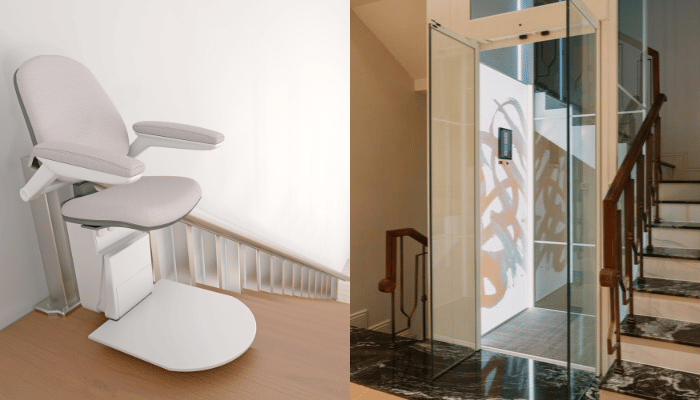
Did you know that over 15% of Australian households now consider installing a home lift or stair lift for better accessibility? With an aging population and more multi-story homes being built, solutions like home lifts and stair lifts are becoming more common.
Both options help you move between floors safely and comfortably but serve different needs.
- Home Lifts: A long-term solution that adds comfort, style, and property value.
- Stair Lifts: A budget-friendly option designed specifically for staircases.
If you’re thinking about improving mobility in your home or planning for the future, understanding the difference between these two solutions can save time and money.
What Are Home Lifts and Stair Lifts?
Home lifts and stair lifts are two of the most popular options. Both make moving between floors easier, but they work differently and suit different needs. Let’s look at what each option offers.
Home Lifts
Home lifts are small elevators for homes designed to move people and goods between floors. They operate vertically and can serve multiple floors, making them a great long-term solution for homes.
Common Features:
- Smooth vertical movement between floors.
- Customizable cabins with various designs and finishes.
- Safety systems like emergency brakes, sensors, and backup power.
Types of Home Lifts:
- Residential Elevators: Compact lifts designed for modern homes with sleek designs and minimal space requirements.
- Platform Lifts: Ideal for wheelchair users, offering open platforms instead of enclosed cabins.
- Hydraulic Lifts: Smooth, reliable, and perfect for larger homes needing higher weight capacity.
Home lifts add comfort and style to multi-story houses. They’re great for families looking for a safe and practical solution to improve mobility.
Stair Lifts
Stair lifts are motorized chairs that move along a rail system fixed to your stairs. They help people with mobility issues travel up and down stairs safely while seated.
Common Features:
- A secure, comfortable seat with safety belts.
- Rail systems installed on straight or curved staircases.
- Remote controls for smooth, easy operation.
Types of Stair Lifts:
- Straight Stair Lifts: Designed for stairs with no curves or turns.
- Curved Stair Lifts: Custom-made to fit staircases with curves or landings.
- Outdoor Models: Built to handle weather conditions for exterior stairs.
Stair lifts are ideal for homes with stairs and limited space for a lift. They’re affordable, easy to install, and perfect for quick accessibility solutions.
Pros and Cons of Home Lifts
Advantages
- Safe and Easy to Use: Home lifts make moving between floors simple and safe for everyone, including the elderly and kids.
- Good for More Than One Person: A home lift can carry a few people, groceries, or even heavy items at once.
- Adds Value to Your Home: Installing a lift can increase your property’s value and make it more appealing to buyers.
- Customizable Designs: You can choose colors, materials, and lighting to match your home’s style.
Disadvantages
- Higher Costs: Lift installation cost is higher compared to stair lifts. They also need regular maintenance.
- Needs More Space: A home lift requires space for installation. Some homes may need small changes or adjustments.
- Takes More Time: Installing a home lift takes longer, often a few weeks, especially if customizations are involved.
Pros and Cons of Stair Lifts
Advantages
- Affordable: Stair lifts are much cheaper than home lifts, making them a budget-friendly option.
- Quick to Install: A stair lift can be installed in just a day or two. It doesn’t require major changes to your home.
- Perfect for Stairs: Stair lifts are great for safely moving up and down a single flight of stairs.
Disadvantages
- Works Only on Stairs: Stair lifts are fixed to your staircase, so they only work for one floor.
- Not Suitable for Wheelchairs: Stair lifts are designed for seated users. They are not ideal for wheelchair users.
- Less Impact on Home Value: Unlike home lifts, stair lifts don’t add much value to your property.
Factors to Consider When Choosing Between Home Lifts and Stair Lifts
Mobility Needs
If you need a long-term solution for multi-floor access or wheelchair use, home lifts are the better option. For short-term needs or simple staircase support, stair lifts work well, especially for elderly residents.
Budget
Stair lifts are more affordable upfront and have lower maintenance costs. Home lifts cost more initially but offer long-term value by improving accessibility and increasing property value. Financing options and government grants in Australia may help with costs.
Space and Home Layout
Home lifts require more space for installation and might involve minor home modifications. Stair lifts fit directly onto straight or curved staircases, making them ideal for homes with limited space.
Aesthetic Preferences
Home lifts are customizable, quiet, and blend seamlessly into modern home designs. Stair lifts are visible and functional but less discreet, focusing purely on convenience.
Making the Right Choice
The choice between a home lift and a stair lift depends on what works best for your family and home. If you’re looking for a long-term solution with added comfort, modern design, and accessibility, SWIFT home lifts are a great choice.
With options like the compact SWIFT Lite for smaller spaces or the premium SWIFT Pro for more advanced needs, SWIFT has something for every home. Both models are reliable, safe, and built to last.
Get in touch with SWIFT today to explore the perfect lift for your space.
FAQs
Home lifts move vertically between floors and can carry multiple users or items. Stair lifts travel along stairs, carrying one person seated.
Home lifts are better for wheelchair users as they offer spacious cabins and smooth vertical movement.
Home lifts require space for a shaft or platform, but modern designs like SWIFT Lite are compact and fit smaller homes.
Yes, financing options and government grants may be available in Australia to help cover installation costs.
Home lifts require regular servicing to ensure smooth operation. Stair lifts need basic maintenance like cleaning rails and checking for wear.
Get in Touch!










